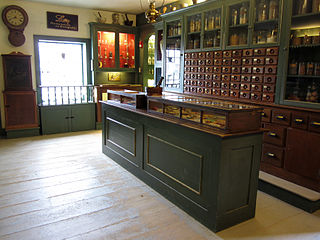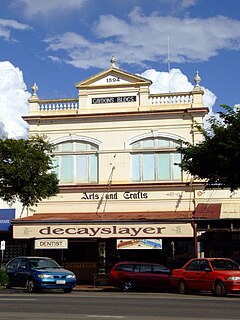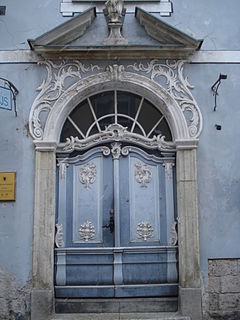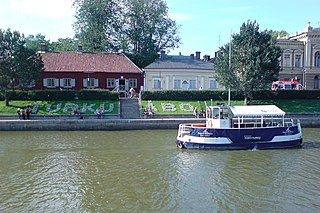 W
WSanto Domingo de Silos Abbey is a Benedictine monastery in the village of Santo Domingo de Silos in the southern part of Burgos Province in northern Spain. The monastery is named after the eleventh-century saint Dominic of Silos.
 W
WThe Adler Apotheke, in Dortmund, is the oldest existing pharmacy in its original location in North Rhine-Westphalia.
 W
WMuzeum Farmacji im. Antoniny Leśniewskiej w Warszawie is a museum of pharmacy in Warsaw, Poland. It was established in 1985. Exhibits include original pharmaceutical laboratory equipment from the 1930s. There are also displays covering the history of Warsaw pharmacies. There are over 2,500 antiquities on display at the museum.
 W
WThe Apothecary Shop is a building at the Shelburne Museum in Shelburne, Vermont, that exhibits objects salvaged from New England pharmacies that were closing in the early decades of the 20th century. The main room contains dried herbs, spices, drugs, and labeled glass apothecary bottles from the nineteenth century, as well as early patent medicines, medical equipment, cosmetics, and a collection of barbers' razors. The compounding room, with its brick hearth, copper distilleries, and percolators, replicates an illustration found in Edward Parrish's 1871 Treatise on Pharmacy.
 W
WThe Cardadeu Tomàs Balvey Museum-Archive, in Cardedeu, Vallès Oriental, is organised around the legacy of Tomàs Balvey i Bas (1865–1954), the last of a line of apothecaries in Cardedeu. The theme of the museum is based on the pharmacy and its pharmacist, focusing on the world of illness, remedies and health. The Museum-Archive is part of the Barcelona Provincial Council Local Museum Network and of the Catalan Pharmacy Museum Network.
 W
WČervený Kláštor is a medieval monastery located in Slovakia. It is located near the village of Červený Kláštor within the Pieniny Mountains, next to the Dunajec River.
 W
WChilders Pharmaceutical Museum is a heritage-listed former pharmacy and now museum at 88-90 Churchill Street, Childers, Bundaberg Region, Queensland, Australia. It was designed by F H Faircloth and built from 1902 to 1909. It is also known as Gaydon's Pharmacy and Tourist Information Centre. It was added to the Queensland Heritage Register on 21 October 1992.
 W
WJonas Salk Hall at the University of Pittsburgh is a Pennsylvania state and Pittsburgh History and Landmarks Foundation Historic Landmark. The Art Deco building is named after Jonas Salk, who conducted his research on the first polio vaccine in a basement laboratory while on the faculty at the University of Pittsburgh.
 W
WThe Esteve Pharmacy is a medieval pharmacy and museum located in the town of Llívia, in the comarca of Cerdanya, Catalonia, Spain. Llívia is a Spanish exclave within the French region of Pyrénées-Orientales. The Esteve Pharmacy, founded at the beginning of the 15th century, is one of the oldest pharmacies in Europe and keeps a collection of albarellos from the 16th and 17th centuries, glass from the 19th century, Renaissance boxes with portraits of saints and personages, a library, laboratory instruments, antique drugs and preparations, old prescription books, and a Baroque "cordialer" cupboard made by Josep Sunyer during the period when the Esteve family managed the pharmacy for up to seven generations. It is one of the most important collections of its kind in Europe.
 W
WHelsinki University Museum is the museum of the University of Helsinki.
 W
WThe Mauksch–Hintz House is a historic building on the Main Square of Cluj-Napoca, Romania, which houses the first pharmacy in the city.
 W
WHugh Mercer Apothecary was a pharmacy founded by Hugh Mercer in the mid-18th century. Mercer was a doctor who fled Scotland after the Battle of Culloden. He travelled to Pennsylvania, where he met Colonel George Washington during the French and Indian War and later moved to Fredericksburg, Virginia, on Washington's advice to practice medicine and operate an apothecary.
 W
WJens Bang's House is a landmark in Aalborg, Denmark. Situated on Østerågade in Nytorv square, it was built in 1624 by Jens Bang in Dutch Renaissance style. Noted for its gables and sculpted auricular window décor, it is said to be the finest privately owned Renaissance building in the country. It also features gargoyles and a sculpture of Bang's face, tongue sticking out. The five-storey building has housed the city's oldest pharmacy for more than 300 years. It is privately owned.
 W
WThe Latvian Museum of Pharmacy is a medical museum in Riga, Latvia. It was founded in 1987 in association with the Pauls Stradins Museum for History of Medicine and is located on Richard Wagner street in an18th century building which itself is an architectural monument. The museum is dedicated to understanding the development of pharmacy and pharmacies in Latvia and contains documents and books from the 17th- 19th century, pharmacist tools and devices for preparing drugs, and drugs which were manufactured in Latvia in the 1920s and 1930s
 W
WThe Lexington History Center once housed several independent history museums in downtown Lexington, Kentucky. It was located in the former Fayette County Courthouse until 2012 when the city closed the building for renovation. Prior to the closing of the building, the Isaac Scott Hathaway Museum moved to a new location on Georgetown Street. The building has since been renovated into a multi-use commercial, tourist, office and event center.
 W
WLloyd Library and Museum is an independent research library located in downtown Cincinnati, Ohio. Its core subject and collection focus is medicinal plants, with emphasis on botany, pharmacy, natural history, alternative medicine, and the history of medicine and science.
The Museum of the History of Lithuanian Medicine and Pharmacy is located in a restored 16th-century building at the Town Hall Square in the Old Town of Kaunas, Lithuania. It moved to its current location in 1987, although its history dates to 1936. Alfonsas Kaikaris (1922–1997), a professor of pharmacy, is credited as the founder of the museum; his personal collection formed the basis of its holdings. The Lithuanian Pharmacists' Union worked to collect materials as well. It is sponsored by Kaunas University of Medicine.
 W
WMuzeum Farmacji Collegium Medicum Uniwersytetu Jagiellońskiego is a museum on Floriańska Street, Kraków, Poland, specializing in the history of pharmacy and pharmaceutical technology. It was established in 1946.
 W
WPharmácia Popular is a pharmacy museum. It is located in town of Bananal in the Brazilian state of São Paulo.
 W
WThe Pharmacy Museum (drugsrore-mesuem) in Lviv, Ukraine, was opened in 1966 in the building of an old drugstore at the corner of the Market Square. It is the working drugstore and museum, the oldest of the existing pharmacies in Lviv. The museum consists of 16 rooms which exhibit antique pharmaceutical appliances, prescriptions, medicines, dishes, a library of pharmacy-related books, and even a reconstructed alchemy workshop.
 W
WThe Pharmacy Museum of the University of Basel shows in its permanent collection the history of remedies and their fabrication. Designed as a collection of evidences and for studies, the museum has been founded in 1924 by Josef Anton Häfliger (1873–1954) and has been preserved until this day in its original form as a 'scientific cabinet'.
 W
WThe Qwensel House is the oldest wooden house in Turku, Finland. It is bourgeois housing from the autarchic times that has survived in its entirety. The house was built approximately in the year 1700 in an area that was reserved for the nobility in the city plan made up by Peter Brahe in 1652. Today, the Qwensel House operates as the Turku Pharmacy Museum and café.
 W
WThe Royal Palace of Madrid is the official residence of the Spanish royal family at the city of Madrid, although now used only for state ceremonies. The palace has 135,000 square metres (1,450,000 sq ft) of floor space and contains 3,418 rooms. It is the largest functioning royal palace and the largest by floor area in Europe.
 W
WJonas Salk Hall at the University of Pittsburgh is a Pennsylvania state and Pittsburgh History and Landmarks Foundation Historic Landmark. The Art Deco building is named after Jonas Salk, who conducted his research on the first polio vaccine in a basement laboratory while on the faculty at the University of Pittsburgh.
 W
WThe Stabler-Leadbeater Apothecary Shop/Museum is a historic apothecary's shop in Alexandria, Virginia, US, that has been preserved as a museum. During its working life, the drug company was owned by generations of a Quaker family. Eventually, a dramatic decline in sales during the Great Depression forced the shop to close its doors. Almost immediately, in 1939, it was reopened as a museum. Today, most of the artifacts inside the shop are authentic and date to its closing. The building was designated a National Historic Landmark in 2021.
 W
WThe Qwensel House is the oldest wooden house in Turku, Finland. It is bourgeois housing from the autarchic times that has survived in its entirety. The house was built approximately in the year 1700 in an area that was reserved for the nobility in the city plan made up by Peter Brahe in 1652. Today, the Qwensel House operates as the Turku Pharmacy Museum and café.